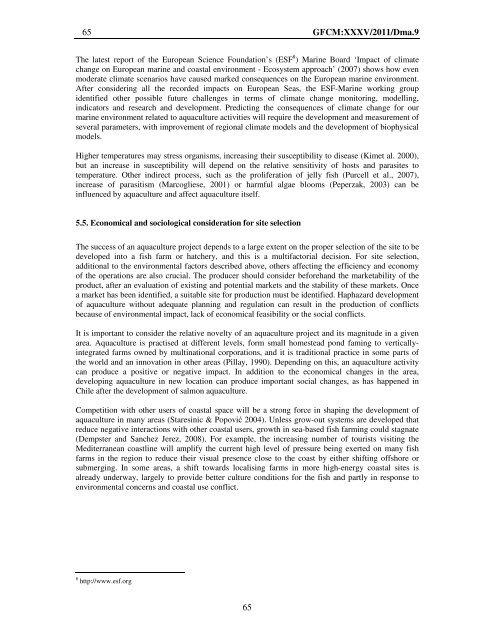Site selection and carrying capacity in Mediterranean ... - FAO Sipam
Site selection and carrying capacity in Mediterranean ... - FAO Sipam
Site selection and carrying capacity in Mediterranean ... - FAO Sipam
Create successful ePaper yourself
Turn your PDF publications into a flip-book with our unique Google optimized e-Paper software.
65 GFCM:XXXV/2011/Dma.9<br />
The latest report of the European Science Foundation’s (ESF 8 ) Mar<strong>in</strong>e Board ‘Impact of climate<br />
change on European mar<strong>in</strong>e <strong>and</strong> coastal environment - Ecosystem approach’ (2007) shows how even<br />
moderate climate scenarios have caused marked consequences on the European mar<strong>in</strong>e environment.<br />
After consider<strong>in</strong>g all the recorded impacts on European Seas, the ESF-Mar<strong>in</strong>e work<strong>in</strong>g group<br />
identified other possible future challenges <strong>in</strong> terms of climate change monitor<strong>in</strong>g, modell<strong>in</strong>g,<br />
<strong>in</strong>dicators <strong>and</strong> research <strong>and</strong> development. Predict<strong>in</strong>g the consequences of climate change for our<br />
mar<strong>in</strong>e environment related to aquaculture activities will require the development <strong>and</strong> measurement of<br />
several parameters, with improvement of regional climate models <strong>and</strong> the development of biophysical<br />
models.<br />
Higher temperatures may stress organisms, <strong>in</strong>creas<strong>in</strong>g their susceptibility to disease (Kimet al. 2000),<br />
but an <strong>in</strong>crease <strong>in</strong> susceptibility will depend on the relative sensitivity of hosts <strong>and</strong> parasites to<br />
temperature. Other <strong>in</strong>direct process, such as the proliferation of jelly fish (Purcell et al., 2007),<br />
<strong>in</strong>crease of parasitism (Marcogliese, 2001) or harmful algae blooms (Peperzak, 2003) can be<br />
<strong>in</strong>fluenced by aquaculture <strong>and</strong> affect aquaculture itself.<br />
5.5. Economical <strong>and</strong> sociological consideration for site <strong>selection</strong><br />
The success of an aquaculture project depends to a large extent on the proper <strong>selection</strong> of the site to be<br />
developed <strong>in</strong>to a fish farm or hatchery, <strong>and</strong> this is a multifactorial decision. For site <strong>selection</strong>,<br />
additional to the environmental factors described above, others affect<strong>in</strong>g the efficiency <strong>and</strong> economy<br />
of the operations are also crucial. The producer should consider beforeh<strong>and</strong> the marketability of the<br />
product, after an evaluation of exist<strong>in</strong>g <strong>and</strong> potential markets <strong>and</strong> the stability of these markets. Once<br />
a market has been identified, a suitable site for production must be identified. Haphazard development<br />
of aquaculture without adequate plann<strong>in</strong>g <strong>and</strong> regulation can result <strong>in</strong> the production of conflicts<br />
because of environmental impact, lack of economical feasibility or the social conflicts.<br />
It is important to consider the relative novelty of an aquaculture project <strong>and</strong> its magnitude <strong>in</strong> a given<br />
area. Aquaculture is practised at different levels, form small homestead pond fam<strong>in</strong>g to vertically<strong>in</strong>tegrated<br />
farms owned by mult<strong>in</strong>ational corporations, <strong>and</strong> it is traditional practice <strong>in</strong> some parts of<br />
the world <strong>and</strong> an <strong>in</strong>novation <strong>in</strong> other areas (Pillay, 1990). Depend<strong>in</strong>g on this, an aquaculture activity<br />
can produce a positive or negative impact. In addition to the economical changes <strong>in</strong> the area,<br />
develop<strong>in</strong>g aquaculture <strong>in</strong> new location can produce important social changes, as has happened <strong>in</strong><br />
Chile after the development of salmon aquaculture.<br />
Competition with other users of coastal space will be a strong force <strong>in</strong> shap<strong>in</strong>g the development of<br />
aquaculture <strong>in</strong> many areas (Stares<strong>in</strong>ic & Popović 2004). Unless grow-out systems are developed that<br />
reduce negative <strong>in</strong>teractions with other coastal users, growth <strong>in</strong> sea-based fish farm<strong>in</strong>g could stagnate<br />
(Dempster <strong>and</strong> Sanchez Jerez, 2008). For example, the <strong>in</strong>creas<strong>in</strong>g number of tourists visit<strong>in</strong>g the<br />
<strong>Mediterranean</strong> coastl<strong>in</strong>e will amplify the current high level of pressure be<strong>in</strong>g exerted on many fish<br />
farms <strong>in</strong> the region to reduce their visual presence close to the coast by either shift<strong>in</strong>g offshore or<br />
submerg<strong>in</strong>g. In some areas, a shift towards localis<strong>in</strong>g farms <strong>in</strong> more high-energy coastal sites is<br />
already underway, largely to provide better culture conditions for the fish <strong>and</strong> partly <strong>in</strong> response to<br />
environmental concerns <strong>and</strong> coastal use conflict.<br />
8 http://www.esf.org<br />
65
















